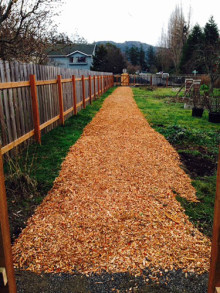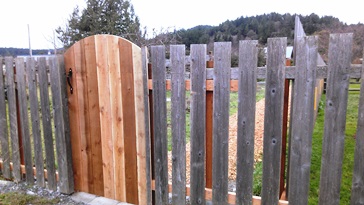— by Margie Doyle —
Earlier this month, County Councilmember Rick Hughes expressed the feeling of many islanders: “I’m so excited to have the parcel officially opened to the public! Public Works did an amazing job!”
He was referring to the long-awaited public access gate and pathway through “the Fern Street Extension,” that lot, owned by County Public Works, that connects North Beach Road to Prune Alley; and the Village Green to the Longhouse.
A latched gate and a sawdust path are now in place where the former Senior Center was located, on the lot in between two privately-owned lots. All three lots have long shared a fence surrounding the properties, but two years ago, when Lila and Ezra Richardson put up their temporary furniture showroom on the northernmost lot, the old gates through the public works lot were replaced with solid fencing.
Requests to open the county-owned lot for public access were delayed while the Eastsound Sub-area Plan was updated and discussions swirled about how to restore the gate and pass-through. Debate continued over whether the lot must be used for a public works project, since it was purchased with public works funding; how any access must be compliant with the Americans with Disabilities Act (ADA); whether the lot should be called a “Transportation Hub;” whether that nomenclature should further be defined as for “multi-modal” or “non-motorized” transport (“multi-modal” won out, in part so that government funds for the lot’s development could be applied for).
In October, 2015, new Public Works Director Brian Vincent promised the Eastsound Planning Review Committee (EPRC) that he would see that latched gates and a sawdust path were installed. The work was accomplished in January through cooperation of Public Works and County Facilities, an General Services agency under the direction of County Manager Mike Thomas. Vincent said the cost of the project was mainly in county labor, with a “modest materials” cost, due to the path being composed of ground-up wood from earlier storm damage.
**If you are reading theOrcasonian for free, thank your fellow islanders. If you would like to support theOrcasonian CLICK HERE to set your modestly-priced, voluntary subscription. Otherwise, no worries; we’re happy to share with you.**









